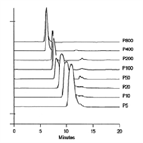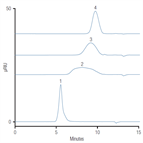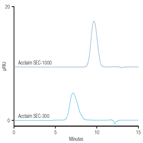Find methods for your needs
Refine by Feature
Displaying 1-5 of 13 results for Tag: SEC
Fast, high resolution size exclusion separation of a protein mix by bio-compatible UHPLC
Instrument Type: HPLC (Biocompatible)A mix of five proteins in varying size was separated on a Thermo Scientific MabPac SEC-1 column using a Thermo Scientific Vanquish UHPLC system. The molecular weight range was 0.13 kDa – 670 kDa. Elution with high resolution of all five proteins was achieved within 15 minutes.
Determination of polyacrylic acid in boiler water by HPLC-CAD
Instrument Type: HPLC-CADThe Thermo Scientific Dionex UltiMate 3000 HPLC system is applied for the analysis of polyacrylic acid in boiler water. The separation is performed on a Thermo Scientific Acclaim SEC-1000 column, with charged aerosol detection.
AN83: Size-Exclusion Chromatography of Polysaccharides with Pulsed Amperometric Detection (PAD).
Instrument Type: ICSize-exclusion chromatography is used in carbohydrate research to determine molecular weight distributions of polysaccharides. Size-exclusion columns separate biological macromolecules by hydrodynamic size. Pulsed amperometric detection (PAD), provides sensitive and specific detection of carbohydrates. Here, fractionated pullulan standards were used to determine the separation range of linear carbohydrates.This application note shows how SEC can be coupled to PAD.
Simple size exclusion chromatography (SEC) of four dextrans with various length
Instrument Type: HPLCThe Thermo Scientific LC system is applied for size exclusion chromatography analysis of four dextrans. The separation is performed on a Thermo Scientific Acclaim SEC-1000 HPLC column, with RI detection.
Simple size exclusion chromatography (SEC) of a dextran
Instrument Type: HPLCThe Thermo Scientific LC system is applied for size exclusion chromatography analysis of a dextran. The separation is performed on a Thermo Scientific Acclaim SEC-300 and an Acclaim SEC-1000 HPLC column, with RI detection. The results are compared.





